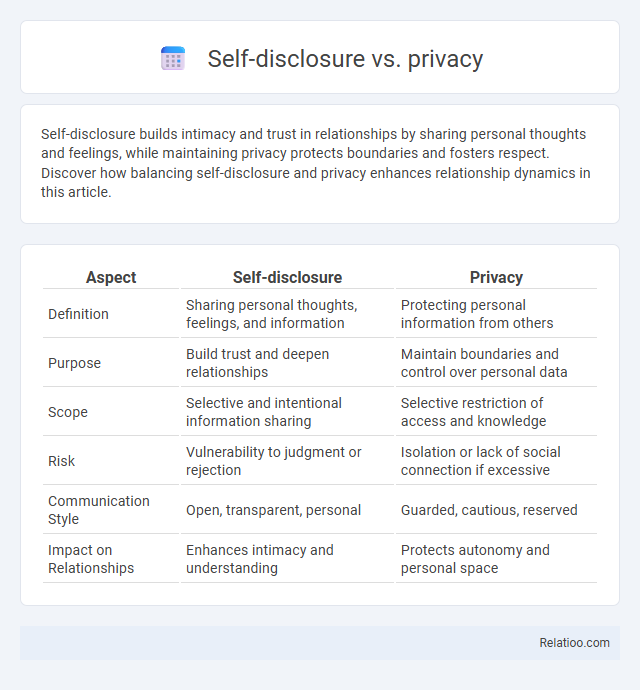Self-disclosure builds intimacy and trust in relationships by sharing personal thoughts and feelings, while maintaining privacy protects boundaries and fosters respect. Discover how balancing self-disclosure and privacy enhances relationship dynamics in this article.
Table of Comparison
| Aspect | Self-disclosure | Privacy |
|---|---|---|
| Definition | Sharing personal thoughts, feelings, and information | Protecting personal information from others |
| Purpose | Build trust and deepen relationships | Maintain boundaries and control over personal data |
| Scope | Selective and intentional information sharing | Selective restriction of access and knowledge |
| Risk | Vulnerability to judgment or rejection | Isolation or lack of social connection if excessive |
| Communication Style | Open, transparent, personal | Guarded, cautious, reserved |
| Impact on Relationships | Enhances intimacy and understanding | Protects autonomy and personal space |
Understanding Self-Disclosure and Privacy
Understanding self-disclosure involves recognizing how sharing personal information can build trust and deepen relationships, while privacy safeguards your right to control what is revealed to others. Balancing self-disclosure with privacy requires careful consideration of the context, audience, and potential impact on your emotional well-being. Your ability to manage this balance enhances communication effectiveness and maintains healthy boundaries.
The Psychology Behind Sharing Personal Information
Self-disclosure involves selectively sharing personal information to build trust and intimacy, while privacy safeguards boundaries to protect one's emotional and psychological well-being. Psychological theories suggest that the decision to disclose hinges on perceived risks and benefits, influenced by individual personality traits, social context, and cultural norms. The balance between embracing openness and maintaining privacy critically shapes interpersonal relationships and self-identity development.
Benefits of Self-Disclosure in Relationships
Self-disclosure in relationships fosters trust and emotional intimacy by allowing individuals to share their thoughts, feelings, and experiences openly. This transparency strengthens bonds and promotes mutual understanding, which enhances relationship satisfaction and stability. Balancing self-disclosure with privacy ensures personal boundaries are respected, preventing vulnerability from turning into discomfort or harm.
Risks of Over-Sharing: Privacy Concerns
Over-sharing personal information on social media or public platforms can lead to significant privacy concerns, including identity theft, cyberbullying, and unwanted surveillance. When you disclose too much about your private life, you increase vulnerability to data breaches and misuse by third parties. Balancing self-disclosure with privacy safeguards is essential to protect your digital footprint and maintain control over your personal information.
Balancing Openness and Personal Boundaries
Balancing openness and personal boundaries involves strategically managing self-disclosure to protect privacy while fostering trust and meaningful connections. Effective self-disclosure requires evaluating the context, audience, and potential consequences to avoid oversharing sensitive information that could compromise personal security or emotional well-being. Maintaining clear boundaries ensures that individuals can share authentic experiences without risking vulnerability or exploitation in interpersonal relationships.
Digital Age Challenges: Self-Disclosure Online
Self-disclosure online presents unique digital age challenges as users navigate the delicate balance between sharing personal information and maintaining privacy. Your online activity exposes sensitive data that can be exploited, highlighting the importance of managing privacy settings and understanding platform policies. Navigating self-disclosure in digital spaces requires heightened awareness of data security risks and potential long-term consequences on reputation and identity.
Cultural Influences on Privacy and Self-Disclosure
Cultural influences significantly shape the boundaries between self-disclosure and privacy, affecting how individuals share personal information in different societies. In collectivist cultures, privacy is often intertwined with group harmony, leading to more restrained self-disclosure to protect social cohesion. Understanding these cultural norms helps you navigate the balance between openness and discretion, ensuring respectful communication across diverse cultural contexts.
Strategies for Protecting Personal Information
Effective strategies for protecting personal information include setting clear boundaries on what you share online, using privacy settings on social media platforms, and regularly updating passwords to prevent unauthorized access. Balancing self-disclosure with privacy requires assessing the risks and benefits of revealing specific details about yourself, ensuring only trusted individuals access sensitive information. Employing encrypted communication tools and being mindful of digital footprints further enhances your control over personal data security.
Impact of Self-Disclosure on Mental Health
Self-disclosure significantly influences mental health by fostering emotional relief and strengthening social support networks, which can reduce stress and anxiety. Excessive or inappropriate self-disclosure risks privacy breaches, potentially leading to feelings of vulnerability and decreased mental well-being. Balancing self-disclosure with privacy boundaries is crucial to maintaining psychological safety and promoting positive mental health outcomes.
Finding Your Comfort Zone: Setting Privacy Limits
Finding your comfort zone involves balancing self-disclosure with privacy, ensuring you share personal information purposefully to protect your boundaries. Setting privacy limits means deciding which details you reveal, to whom, and when, preventing oversharing while fostering genuine connections. Understanding these borders empowers you to maintain control over your digital and real-world interactions, safeguarding your emotional well-being.

Infographic: Self-disclosure vs Privacy
 relatioo.com
relatioo.com